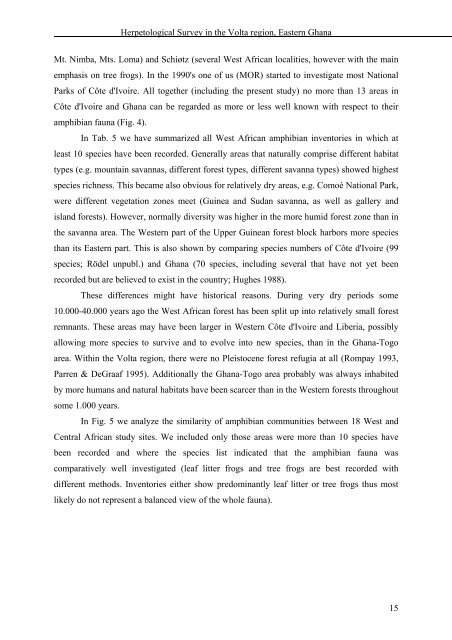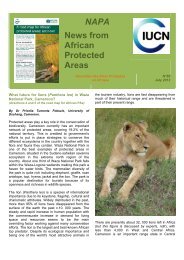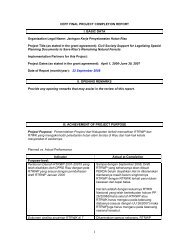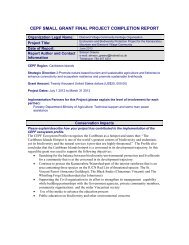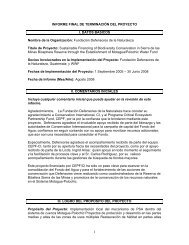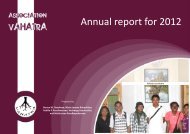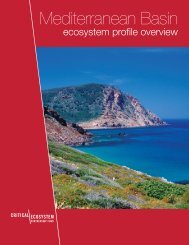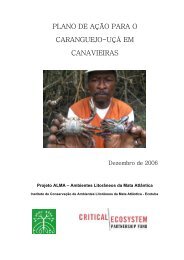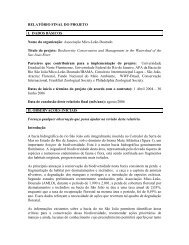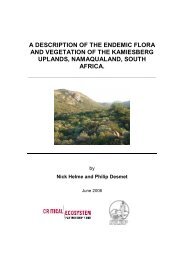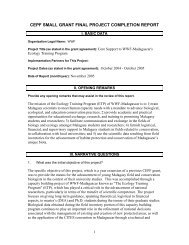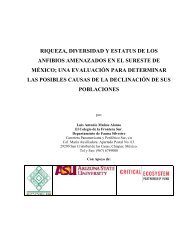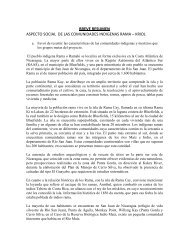Herpetological survey in the Volta region, Eastern Ghana - Critical ...
Herpetological survey in the Volta region, Eastern Ghana - Critical ...
Herpetological survey in the Volta region, Eastern Ghana - Critical ...
Create successful ePaper yourself
Turn your PDF publications into a flip-book with our unique Google optimized e-Paper software.
<strong>Herpetological</strong> Survey <strong>in</strong> <strong>the</strong> <strong>Volta</strong> <strong>region</strong>, <strong>Eastern</strong> <strong>Ghana</strong><br />
Mt. Nimba, Mts. Loma) and Schiøtz (several West African localities, however with <strong>the</strong> ma<strong>in</strong><br />
emphasis on tree frogs). In <strong>the</strong> 1990's one of us (MOR) started to <strong>in</strong>vestigate most National<br />
Parks of Côte d'Ivoire. All toge<strong>the</strong>r (<strong>in</strong>clud<strong>in</strong>g <strong>the</strong> present study) no more than 13 areas <strong>in</strong><br />
Côte d'Ivoire and <strong>Ghana</strong> can be regarded as more or less well known with respect to <strong>the</strong>ir<br />
amphibian fauna (Fig. 4).<br />
In Tab. 5 we have summarized all West African amphibian <strong>in</strong>ventories <strong>in</strong> which at<br />
least 10 species have been recorded. Generally areas that naturally comprise different habitat<br />
types (e.g. mounta<strong>in</strong> savannas, different forest types, different savanna types) showed highest<br />
species richness. This became also obvious for relatively dry areas, e.g. Comoé National Park,<br />
were different vegetation zones meet (Gu<strong>in</strong>ea and Sudan savanna, as well as gallery and<br />
island forests). However, normally diversity was higher <strong>in</strong> <strong>the</strong> more humid forest zone than <strong>in</strong><br />
<strong>the</strong> savanna area. The Western part of <strong>the</strong> Upper Gu<strong>in</strong>ean forest block harbors more species<br />
than its <strong>Eastern</strong> part. This is also shown by compar<strong>in</strong>g species numbers of Côte d'Ivoire (99<br />
species; Rödel unpubl.) and <strong>Ghana</strong> (70 species, <strong>in</strong>clud<strong>in</strong>g several that have not yet been<br />
recorded but are believed to exist <strong>in</strong> <strong>the</strong> country; Hughes 1988).<br />
These differences might have historical reasons. Dur<strong>in</strong>g very dry periods some<br />
10.000-40.000 years ago <strong>the</strong> West African forest has been split up <strong>in</strong>to relatively small forest<br />
remnants. These areas may have been larger <strong>in</strong> Western Côte d'Ivoire and Liberia, possibly<br />
allow<strong>in</strong>g more species to survive and to evolve <strong>in</strong>to new species, than <strong>in</strong> <strong>the</strong> <strong>Ghana</strong>-Togo<br />
area. With<strong>in</strong> <strong>the</strong> <strong>Volta</strong> <strong>region</strong>, <strong>the</strong>re were no Pleistocene forest refugia at all (Rompay 1993,<br />
Parren & DeGraaf 1995). Additionally <strong>the</strong> <strong>Ghana</strong>-Togo area probably was always <strong>in</strong>habited<br />
by more humans and natural habitats have been scarcer than <strong>in</strong> <strong>the</strong> Western forests throughout<br />
some 1.000 years.<br />
In Fig. 5 we analyze <strong>the</strong> similarity of amphibian communities between 18 West and<br />
Central African study sites. We <strong>in</strong>cluded only those areas were more than 10 species have<br />
been recorded and where <strong>the</strong> species list <strong>in</strong>dicated that <strong>the</strong> amphibian fauna was<br />
comparatively well <strong>in</strong>vestigated (leaf litter frogs and tree frogs are best recorded with<br />
different methods. Inventories ei<strong>the</strong>r show predom<strong>in</strong>antly leaf litter or tree frogs thus most<br />
likely do not represent a balanced view of <strong>the</strong> whole fauna).<br />
15


